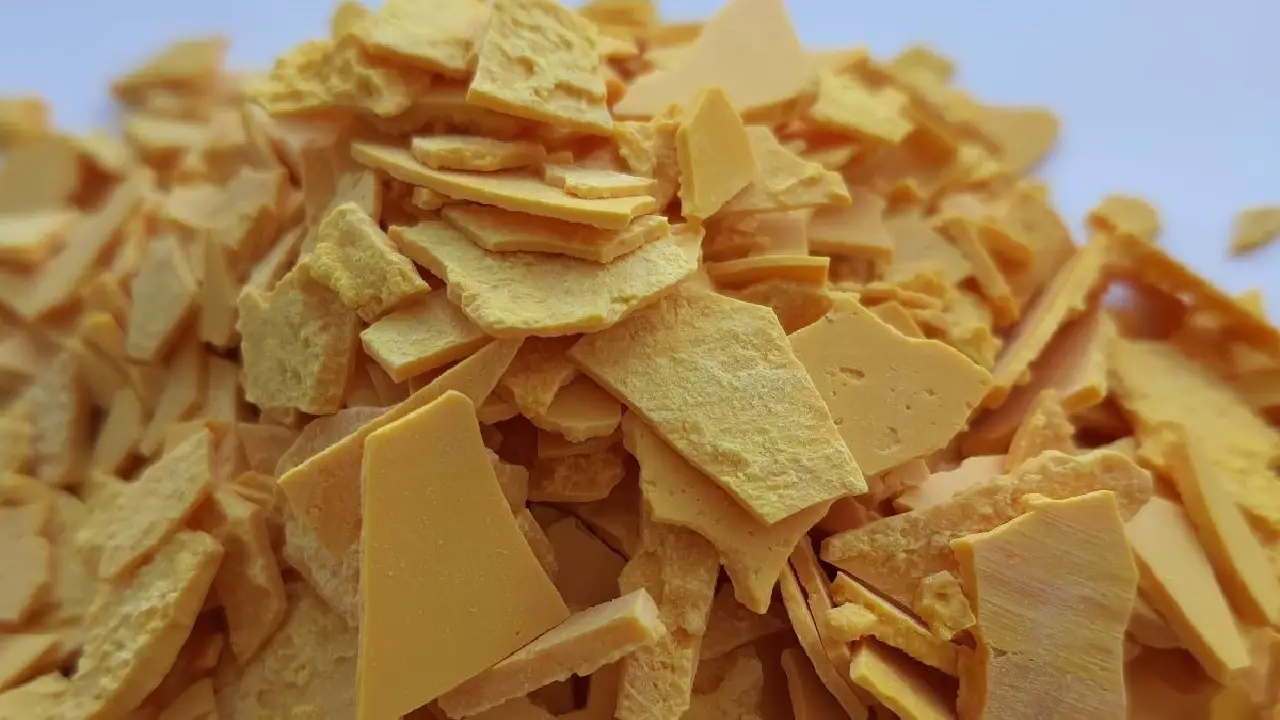Supplier of Sodium Sulfide from Turkey and Dubai UAE

Descriptions of Sodium Sulfide
Sodium Sulfide is a vital inorganic chemical used across many industries for its strong alkaline and reducing properties. With the chemical formula Na₂S and its hydrated form Na₂S·9H₂O, it dissolves easily in water, forming clear, strongly alkaline solutions. Although sodium sulfide appears as a yellow solid, its solutions are colorless. One of its distinctive features is the emission of hydrogen sulfide (H₂S) gas, which has a pungent “rotten egg” odor when exposed to air.
Sodium sulfide also reacts with hydrogen peroxide to produce sodium sulfate, making it a versatile chemical in industrial processes.
Properties of Sodium Sulfide
-
Appearance: Yellow to red solid, depending on impurities
-
Odor: Strong rotten egg smell due to H₂S
-
Molecular Weight: 78.04 g/mol
-
Melting Point: ~1,175°C (2,147°F)
-
Solubility: Highly soluble in water, forming a strongly alkaline solution
-
Hydrated Forms: Most commonly Na₂S·9H₂O, which is more stable and easier to handle
-
Ionic Nature: Contains two sodium ions (Na⁺) and one sulfide ion (S²⁻)
Applications of Sodium Sulfide
Sodium sulfide finds applications in a wide range of industries due to its chemical reactivity:
Pulp and Paper Industry
-
Kraft Process: Breaks down lignin in wood, aiding cellulose fiber separation for paper production.
Textile Industry
-
Dyeing and Bleaching: Functions as a reducing agent to fix dyes and remove excess color.
-
Desulfurizing and Dechlorinating: Eliminates sulfur and chlorine compounds, improving fabric quality.
Leather Industry
-
Tanning: Used to remove hair from hides and soften leather for processing.
Chemical Industry
-
Production of Sulfur Compounds: Serves as a precursor for manufacturing sodium thiosulfate, sodium polysulfide, and other sulfur-containing chemicals.
-
Reducing Agent: Commonly used in organic and inorganic reactions to donate electrons and reduce other substances.
-
Na₂S is often used alongside other industrial chemicals, such as Caustic Soda Flakes, to enhance chemical processes in pulp, textile, and chemical manufacturing.
Water Treatment
-
Wastewater Treatment: Helps precipitate heavy metals, making industrial effluents safer to release.
Mining Industry
-
Ore Flotation: Assists in separating valuable minerals by altering the surface properties of ores.
Rubber Industry
-
Vulcanization: Improves the elasticity and strength of rubber products.
Oil & Gas Industry
-
Desulfurization: Removes sulfur compounds from petroleum and gas, improving fuel quality and reducing emissions.
Photographic Industry
-
Film Development: Acts as a fixing agent to dissolve unexposed silver halide crystals in films and papers.
Electronics & Batteries
-
Sodium-Sulfur Batteries: Used as an electrolyte, providing high energy efficiency.
Agriculture
-
Pesticides and Fungicides: Used in formulations to control pests and fungal infections.
Safety, Handling, and Storage
Handling sodium sulfide requires caution due to its toxicity and corrosiveness:
-
Toxicity: Can irritate skin, eyes, and the respiratory system. Contact with acids releases poisonous H₂S gas.
-
Corrosiveness: Can damage metals and other materials.
-
Storage: Store in a cool, dry, well-ventilated area, away from acids and moisture. Proper ventilation is essential to prevent gas accumulation.
Packing and Transportation
-
Forms: Crystallized, broken, or prilled
-
Packaging: Polyethylene bags, fiber drums, or IBC containers
-
Container Loading: Sodium sulfide is typically loaded into 20–25 MT containers, ensuring proper stacking and protection from moisture. Ventilation during transport is important to prevent hydrogen sulfide buildup.
Environmental Considerations
-
Aquatic Toxicity: Harmful to aquatic life; effluents must be treated before release.
-
Biodegradability: Can naturally decompose, but high concentrations can cause ecological damage.
Technical Data Sheets of Sodium Sulfide
| SPECIFICATIONS | RESULTS |
|---|---|
| Appearance | Yellow Flakes |
| Na2S, % | 60 ± 2 |
| Na2SO3, % | < 2 |
| Na2CO3, % | < 0.5 |
| Fe, ppm | < 10 |
| Insoluble Content, % | < 12 |
| Density, g/ cmᵌ | 1600 |
| Melting Point, ℃ | 92 |

